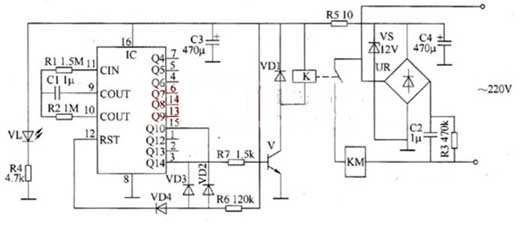Design of Intermittent Controller Circuit for lm358 Electronic Temperature Controller
The intermittent controller introduced in this example can automatically control the electric power devices such as electric heaters, humidifiers, and single-phase AC motors to make them work intermittently.
Circuit working principle
The intermittent controller circuit consists of a power supply circuit, a timer, and a control execution circuit as shown.

The timer circuit is composed of a counter/divider integrated circuit IC, a capacitor C1, diodes VD2 to VD4, and resistors R1, R2, and R6. The circuits in R1, R2, C1 and IC form the clock oscillator circuit, and the oscillation period (T) is determined by the values of R2 and C1.
The control execution circuit is composed of a transistor V, a resistor R7, a diode VD1, a relay K, and an AC contactor KM.
After the AC 220V voltage is stepped down by C2, UR rectified, VS regulated, R5 current limited and C3 filtered, 12V DC voltage is supplied to the relay K and IC, and VL is lit at the same time.After the IC is powered on, the oscillating signal generated by the clock oscillator is counted and frequency-divided. When the on-delay time (waiting time) ends. The Q14 end (3 pins) of the IC outputs a high level, which turns V on, K and KM pull in, and turns on the working power of the load (controlled power supply). At the same time, the IC starts counting the working time (working time). When the working time is over, the Q14 end of the IC becomes low, so that V is cut off, K and KM are released, and the load is powered off. At the same time, the internal counter of the IC is reset and enters the next timing cycle. Repeatedly so, the load is intermittently energized for a set time. Adjust the parameters of R2 and C1 or change the control connection of the Q4~Q14 output of the IC to set the delay on time and the scheduled working time. According to the parameter value in the circuit, the delay on time is 3h, and the timing operation time is 20min.
C1 uses monolithic capacitors;
C2 selects a CBB capacitor with a withstand voltage of 450V;
C3 selects aluminum electrolytic capacitor with a withstand voltage of 16V;
C4 uses an aluminum electrolytic capacitor with a withstand voltage of 25V.
VD1 selects 1N4001 type silicon rectifier diode for use;
VD2 ~ VD4 select 1N4148 type silicon switch diode.
VS selects 1N4742 (1W, 12V) type silicon steady voltage diode.
VL selects φ5mm LED.
UR selects 1A, 100V rectifier bridge stack.
V selects 58050 or C8050, 3DG8050 type silicon NPN transistor.
IC selects CD4060 or CC4060 type 14-bit binary count/divider integrated circuit.
K uses 4098 type 12V DC relay.
KM selects AC contactor with coil voltage of 220V, and its contact current capacity should be selected according to the actual power of the load.
Circuit working principle
The intermittent controller circuit consists of a power supply circuit, a timer, and a control execution circuit as shown.

figure 1 Temperature intermittent controller circuit
The power supply circuit is composed of capacitors C2 to C4, resistors R3 to R5, rectifier bridge stack UR, Zener diode VS, and power indicating LED VL.The timer circuit is composed of a counter/divider integrated circuit IC, a capacitor C1, diodes VD2 to VD4, and resistors R1, R2, and R6. The circuits in R1, R2, C1 and IC form the clock oscillator circuit, and the oscillation period (T) is determined by the values of R2 and C1.
The control execution circuit is composed of a transistor V, a resistor R7, a diode VD1, a relay K, and an AC contactor KM.
After the AC 220V voltage is stepped down by C2, UR rectified, VS regulated, R5 current limited and C3 filtered, 12V DC voltage is supplied to the relay K and IC, and VL is lit at the same time.After the IC is powered on, the oscillating signal generated by the clock oscillator is counted and frequency-divided. When the on-delay time (waiting time) ends. The Q14 end (3 pins) of the IC outputs a high level, which turns V on, K and KM pull in, and turns on the working power of the load (controlled power supply). At the same time, the IC starts counting the working time (working time). When the working time is over, the Q14 end of the IC becomes low, so that V is cut off, K and KM are released, and the load is powered off. At the same time, the internal counter of the IC is reset and enters the next timing cycle. Repeatedly so, the load is intermittently energized for a set time. Adjust the parameters of R2 and C1 or change the control connection of the Q4~Q14 output of the IC to set the delay on time and the scheduled working time. According to the parameter value in the circuit, the delay on time is 3h, and the timing operation time is 20min.
Component selection
R1 ~ R4, R6 and R7 use 1/4W metal film resistors: R5 selects 1/2W metal film resistors.C1 uses monolithic capacitors;
C2 selects a CBB capacitor with a withstand voltage of 450V;
C3 selects aluminum electrolytic capacitor with a withstand voltage of 16V;
C4 uses an aluminum electrolytic capacitor with a withstand voltage of 25V.
VD1 selects 1N4001 type silicon rectifier diode for use;
VD2 ~ VD4 select 1N4148 type silicon switch diode.
VS selects 1N4742 (1W, 12V) type silicon steady voltage diode.
VL selects φ5mm LED.
UR selects 1A, 100V rectifier bridge stack.
V selects 58050 or C8050, 3DG8050 type silicon NPN transistor.
IC selects CD4060 or CC4060 type 14-bit binary count/divider integrated circuit.
K uses 4098 type 12V DC relay.
KM selects AC contactor with coil voltage of 220V, and its contact current capacity should be selected according to the actual power of the load.





